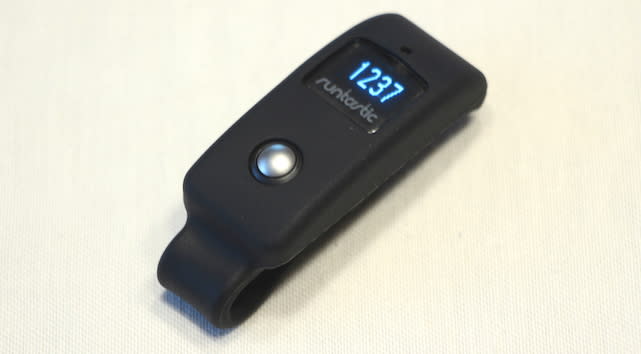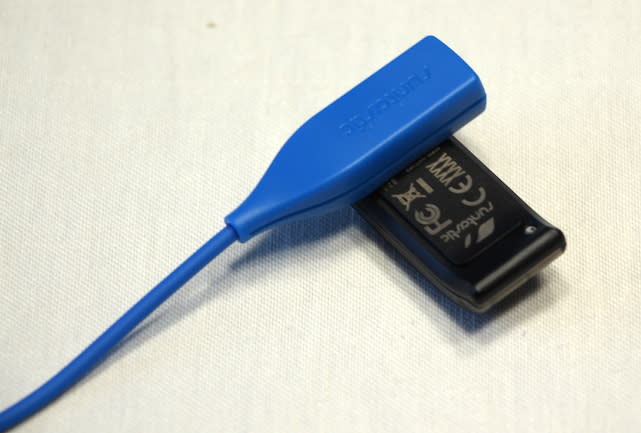Runtastic Orbit: The new activity tracker on the block

It seems like everyone is getting into the wearables market these days. There's Fitbit, Misfit, Nike Fuel Band, Withings Pulse, and about twenty others I can think of. So when a new tracker shows up on the market, it has to have some redeeming value to make it stand out from all of the others. Recently I was approached by Runtastic about doing a review of their new Orbit fitness band (US$119.99). Runtastic is primarily known for a number of activity tracking apps as well as a hardware line with heart rate monitors and bike accessories among the favorites.
Design Highlights
The Runtastic Orbit is a tiny device about 1.89 x .71 x .35 (at thickest point) inches (4.8 x 1.8 x .9 cm), weighing just .3 ounce (8.5 grams). It's made of a translucent smoked plastic, although you'll rarely see that plastic because the tracker is installed into either a wristband or belt clip. Runtastic provides two wristbands and a belt clip with each device -- the review unit came with black and blue silicone wristbands, although you can also purchase accessory bands in other colors.
The front of the Orbit is dominated by three things: an white on black OLED display, a large and easily pushed metal button, and a tiny light sensor that is barely visible. The back contains the recessed contacts for the USB charger.
The wristbands are quite comfortable -- important if you're going to wear the Orbit 24 hours a day -- and designed so that they're very easy to put on. I've tested some fitness trackers that I've wanted to throw out simply because the wristbands were almost impossible to put on, but that's certainly not the case with the Orbit band.
The belt clip (seen in the image at the top of this page) is also well designed. When you place the Runtastic Orbit into the flexible silicone rubber clip, it's upside down, which means that you can actually read the display -- smart design, since you don't have to take the clip off in order to read it. The clip also has a rather strong grip, important for making sure that you don't lose the Orbit.
Battery life in my testing was about one week. At the end of that time, I simply recharged the Orbit using the included USB charging cable. During charging, an animated display shows the battery "filling up", which is a nice visual cue. One end of the cable plugs into a standard USB port, while the other end has two small contacts embedded into a plastic head that has a strong magnet in it. The design of the prototype cable caused a problem, which I'll describe in the next section of this review.
Finally, the device synchronizes with a new, free Runtastic Me iOS app. That app can pass along information about your exercise to the Runtastic or Runtastic Pro apps.
Functionality Highlights
As a fitness tracker, the Runtastic Orbit does a really good job. It tracks steps taken, sleep duration, will show calories burned, can be used as a watch and alarm, and as noted above, it has good battery life compared to a lot of trackers. Part of this is due to the fact that you need to push the button to see the time or how many steps you've taken -- that display is off otherwise, helping extend that battery life. Each push of the button takes you to another screen -- first the time, then steps taken, then calories burned, and finally active minutes. The display is easy to read both in dark rooms and in full sunlight.

Most fitness trackers are designed to work hand-in-hand with a companion app, and in this case, the default app is Runtastic Me. Upon launching the app, it connects to the device via Bluetooth and synchronizes automatically. The display of Runtastic Me shows the current number of steps taken, active minutes during the present day, the number of calories burned, distance walked in miles or kilometers and, if you've enabled sleep tracking, the hours of sleep you had the previous evening.
Tapping on any of the items displays more detailed stats, including a timeline of when you were active. By swiping up you can move to the detail displays for the other tracked items, and for things like steps taken, a tap and hold on the display shows how many steps you had take up until the selected time.
Enabling sleep tracking is quite simple. You simply hold down the button for three seconds as you're going to sleep, and a "bed" icon appears to let you know you're now tracking sleep. When you're waking up, just hold down the button for three seconds again, and a "sunrise" animation is your indication that sleep tracking has been turned off. Launch the Runtastic Me app, and you'll have almost immediate data on how well (or poorly) you slept the previous evening.
Runtastic shows that the device will do "mood tracking", but it did not appear that the feature has been enabled yet. The Orbit is also supposed to do ambient lighting tracking so that you can make sure that you're getting enough sunlight each day, but that is also something that will come in the future with a firmware upgrade.
As with most of the fitness trackers on the market, Orbit uses vibration alerts to wake you up in the morning (alarms are set through the app) or to prompt you to get moving. It's a good strong vibration, guaranteed to get your attention.
One of the best features of the Runtastic Orbit is that it is complete waterproof. You can swim with it on, take a shower, or even go diving down to 300 feet with it. No other fitness tracker is waterproof to that extent, and a number (Nike FuelBand SE, Withings Pulse O2, Fitbit Flex, Jawbone UP24) are either just water-resistant or have no ability to withstand water at all.
I was quite impressed with the fact that the Orbit lives up to its battery life of 7 days. That's almost exactly what I got from a full charge. The accuracy of the Orbit's step tracker is up for debate. I matched the steps taken with another activity tracker as well as my iPhone 5s, and when I used the belt clip, the numbers were almost identical. I did see lower step numbers when I used the wristband, which was a bit of an anomaly.
Charging with the prototype magnetic charging cable (blue cable below) caused a problem at one point. The magnet in the cable made it stick to the metal end of another cable, shorting it out and melting the charging cable. I reported the issue to Runtastic; they are redesigning the charger cable (I was using a prototype) and will have a revised version with all shipping Orbits. I would still recommend unplugging the cable when it is not in use.

Conclusion
Runtastic's Orbit activity tracker is another welcome entry to an increasingly crowded market. At $119.99, it's slightly more expensive than the Nike FuelBand SE, Fitbit Flex, Misfit Shine and the Polar Loop, less expensive than the Jawbone UP24 and Garmin Vivofit, and the same price as the Withings Pulse O2.
Waterproof to 300 feet, with some planned features (mood and ambient light tracking) that don't exist on most competitors, a choice of how the device is worn, good battery life, and a well-designed app, the Orbit is a solid competitor. Two factors -- the lower step count when worn as a wristband and two advertised features that are not working at this time -- are keeping me from giving the Orbit a top score.
Rating: 3 stars out of 4 stars possible


